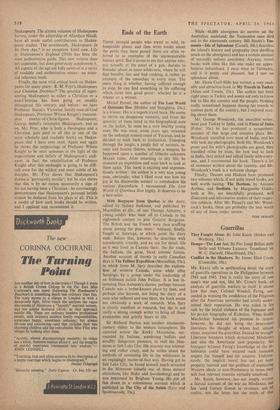Ends of the Earth
THOSE intrepid people who travel to wild, in- hospitable places and then write books about the perils they have passed there are often re- ferred to as examples of the unconquerable human spirit. But it seems to me that anyone who, not actually at the point of a gun, decides to flounder about in some wilderness, where he will find bandits, lice and bad cooking, is rather an example of the masochist in every man. The main thing is whether, having suffered enough to stop, he can find something in his suffering which turns into good prose: whether he is a whiner or a winner.
Michel Peissel, the author of The Lost World of Quintana Roo (Hodder and Stoughton, 25s,), is a winner. His is a superb travel book. He seems to thrive on dangerous ventures, and from the quantity of them listed in the biographical note on the jacket, he must be a very healthy young man. He was once, some years ago, stranded on the unkempt eastern coast of Yucatan, and he decided to walk back to civilisation. Tramping through the jungle, a jungle full of animals, in- sects and human thieves, without a weapon, he happened upon a number of hitherto unknown Mayan ruins. After returning to oity life, he mounted an expedition and went back to look at them again. This book is exciting and unpreten- tiously written: the author is a very nice young man, obviously; what I liked most was how his joy in his discoveries seemed to overshadow his various discomforts, I recommend The Lost World of Quintana Roo highly. It deserves to be a best-seller.
With Burgoyne from Quebec is the diary, edited by Sydney Jackman, and published by Macmillan at 42s., of one Thomas Anburey, a young soldier who went off to Canada in the eighteenth century to join General Burgoyne. The British and the French were then scuffling about among the pine trees: Anburey, finally, fought at Saratoga, at which point the diary ends. Before that, however, he describes with considerable vivacity, and an eye for detail, life as it was lived in Canada then: the fur trade, the Indians, the great, bleak totemic forests. Another account of travels in early Canadian days is The Palliser Expedition (Macmillan, 55s.), in which Irene M. Spry describes the explora- tion of western Canada, some while after Saratoga, by a group under the leadership of an Irishman Called John Palliser. It is less in- teresting than Anburey's diaries, perhaps because Canada was a better-known place by then, and perhaps also because, not being the diary of a man who suffered and was there, the book seems too obviously a work of research. Miss Spry is clearly excellent at research, but she is not really a strong enough writer to bring all those avalanches and grizzly bears to life.
Sir Richard Burton was another nineteenth- century visitor to the western hemisphere. He careered across the Rocky Mountains, sur- rounded by Indians, wandering buffalo and scruffily dangerous pioneers, to visit the Mor- mons at Salt Lake City. His journey was interest- ing and rather crazy, and he writes about the methods, of sustaining life in the wilderness in an engagingly matter-of-fact way. Having got to Salt Lake City, he found himself much attracted to the Mormons (clearly one of those natural attractions, like Blake and Swedenborg) and he was impressed by Brigham Young. He put all this down in a voluminous account which is published as The City of the Saints (Eyre and Spottiswoode, 70s.). While 46,000 aborigines do survive on the Australian mainland, the Tasmanian ones died out in the nineteenth century. Bill Beatty's Tas- mania—Isle of Splendour (Cassell, 30s.) describes the island's history and geography (not dwelling much on the aborigines) and has a certain amount of normally tedious anecdotes. Anyway, travel hooks with titles like this one make me appre- hensive beforehand. I once went to Tasmania, and it is pretty and pleasant, but I saw no splendour about.
Mr. Denis Cecil Hills has written a very read- able and attractive book in My Travels in Turkey (Allen and Unwin, 35s.). The author has lived eight years in Turkey and seems not only to know but to like the country and the people. Nothing really sensational happens during his travels to various parts of the country, but I enjoyed read- ing about them.
Mr. George Woodcock, the anarchist writer, went past Turkey to India, and in Faces of India (Faber, 30s.) he has produced a sympathetic account of that large and complex place. Mr. Woodcock travelled over most of India, and his wife took the photographs. Both Mr. Woodcock's prose and his wife's photographs are good, they travelled often by train, the best way to look at India, they mixed and talked freely with every- one, and I recommend his book. There's a lot of nonsense written about the country, and Mr. Woodcock's book is a welcome change.
Finally, Thames and Hudson have produced two volumes which, if not quite travel books, are well worth having. The Iberians, by Antonio Arribas, and Sardinia, by Marguerite Guido, both at 30s., are beautifully produced, well illustrated and informative studies of their respec- tive subjects. After Mr. Peissel's and Mr. Wood- cock's books, these are probably the best worth of any of those under review.
DOM MORAES






































 Previous page
Previous page